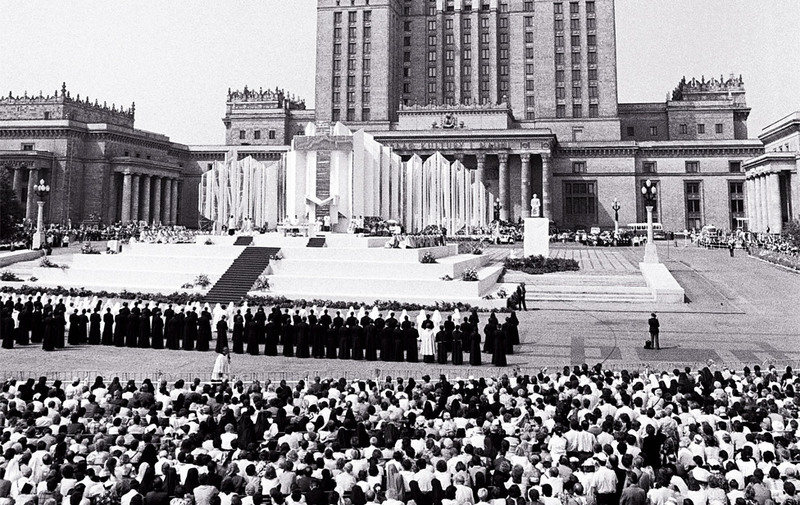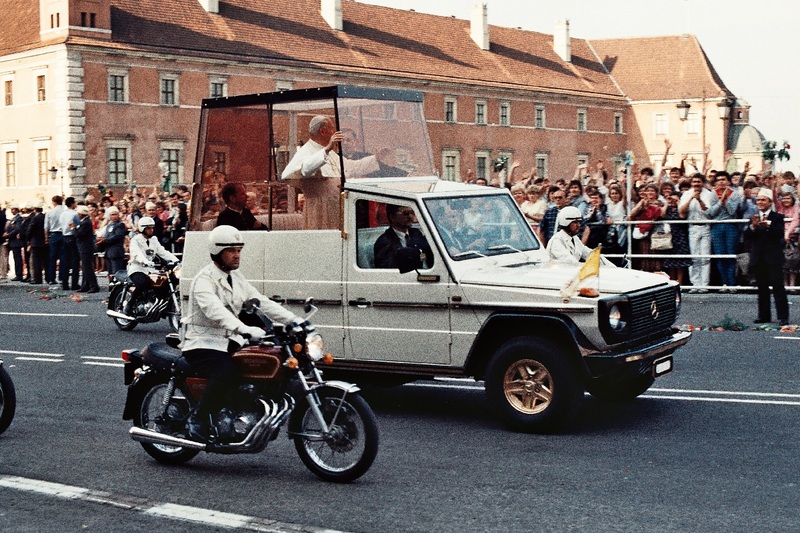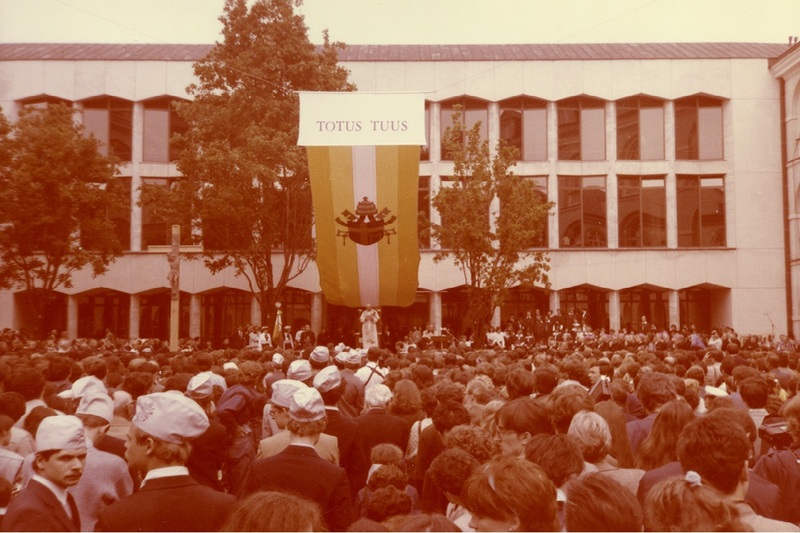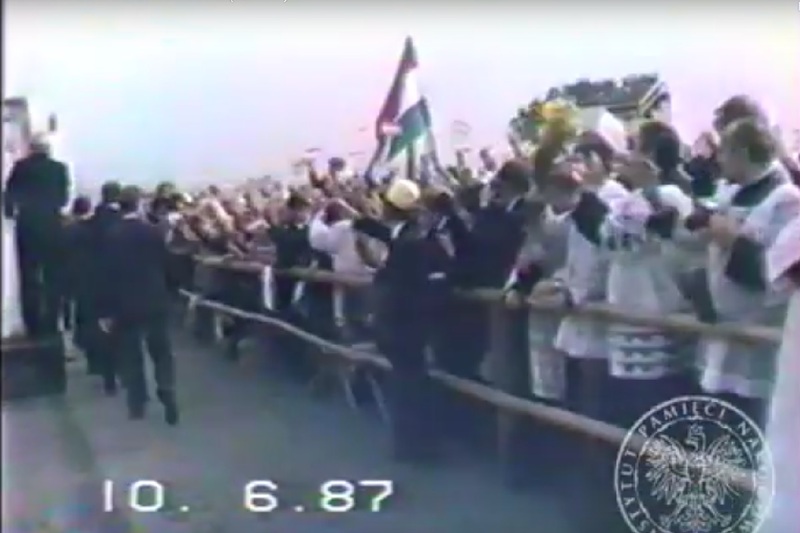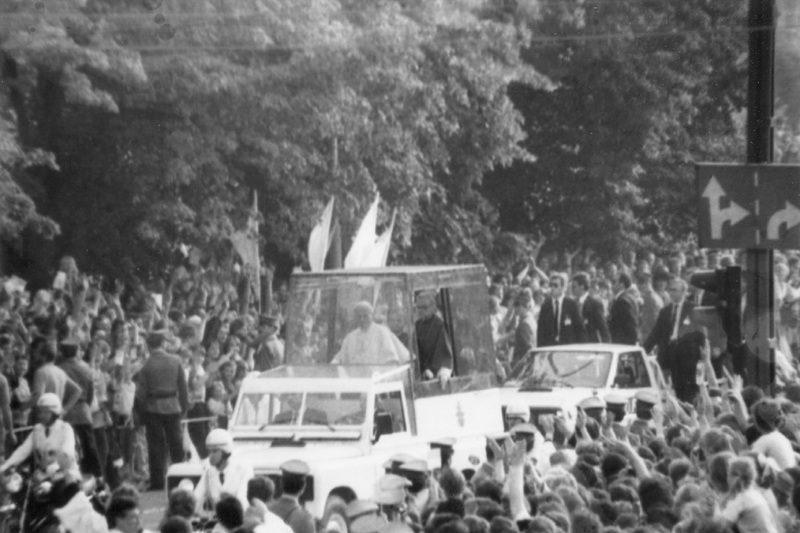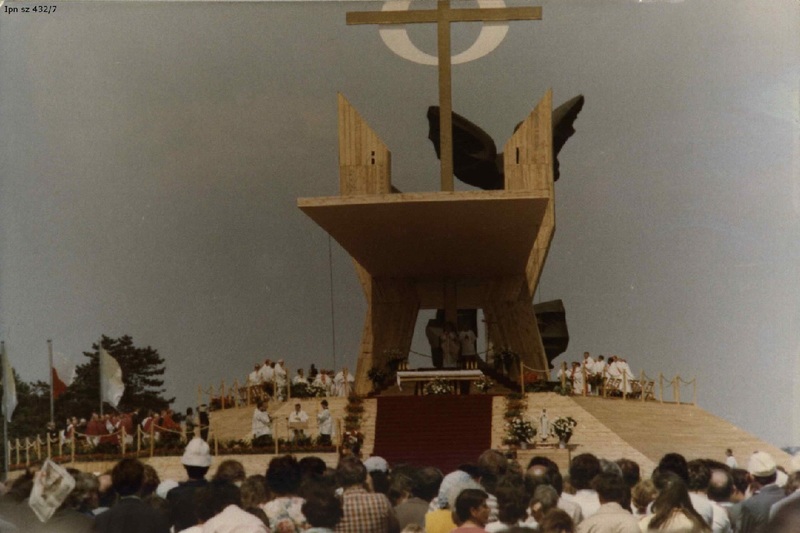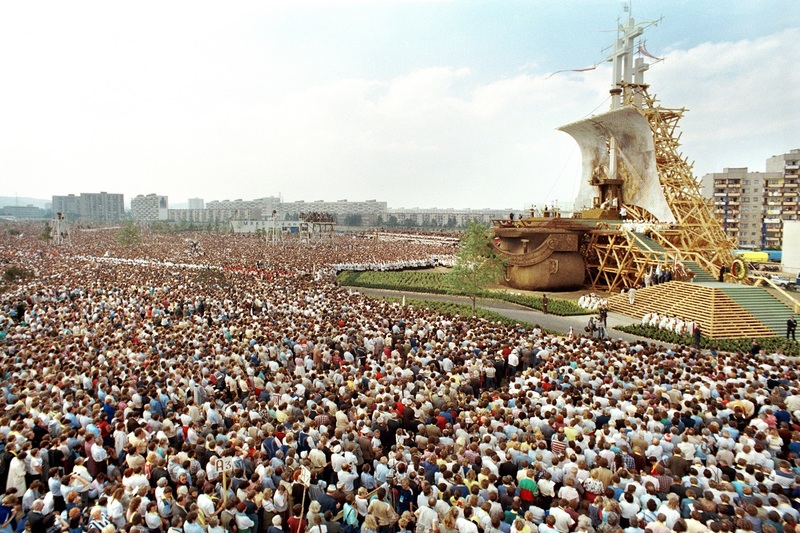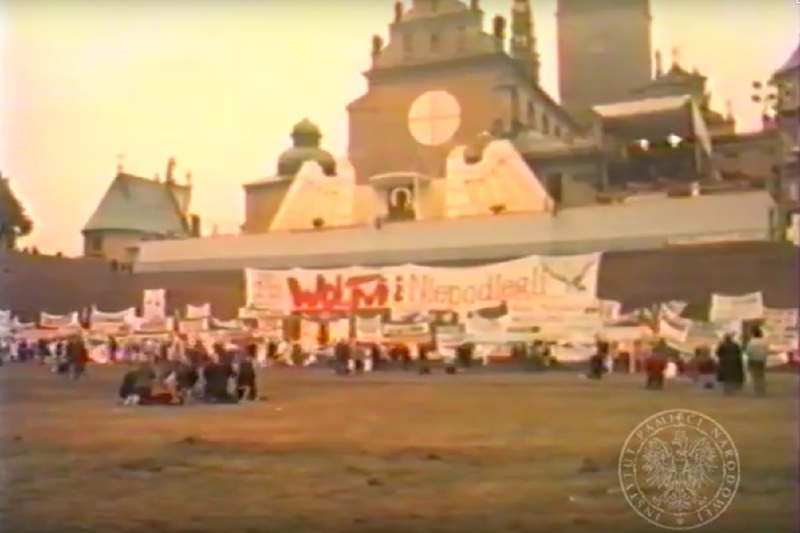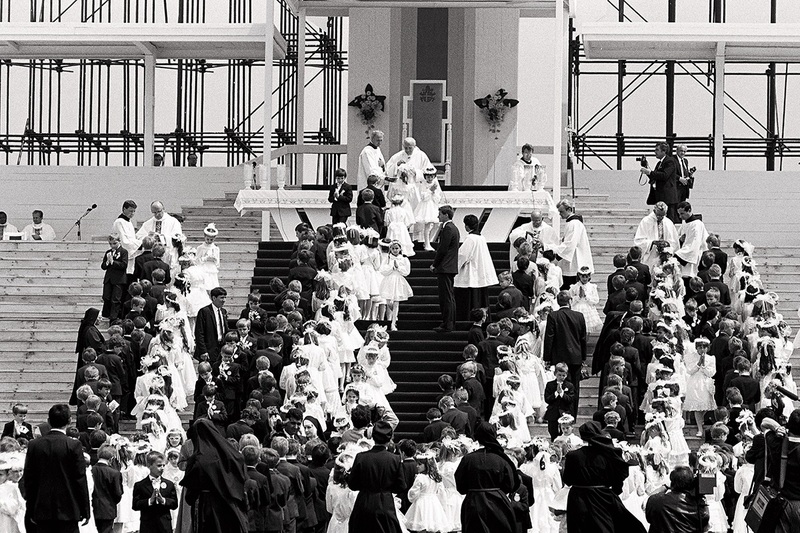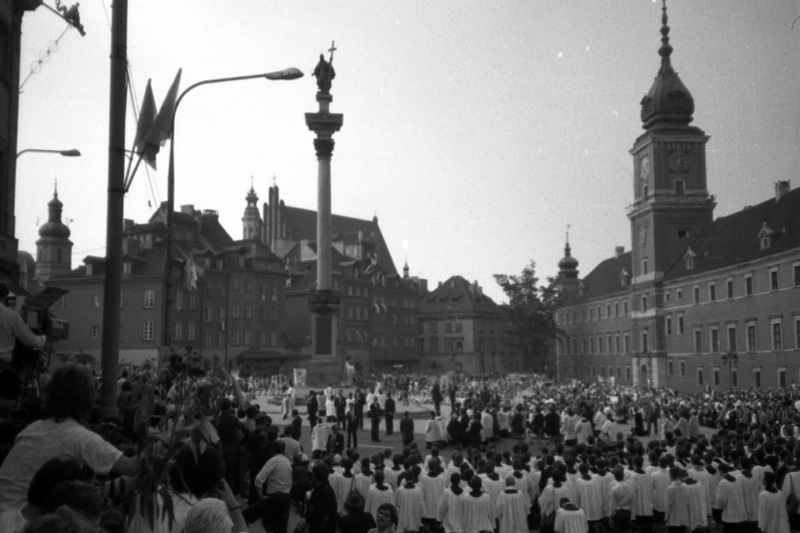Introduction 1987
In the footsteps of the third visit of John Paul II to the Polish People’s Republic.
The official reason of the Pope’s arrival was to attend the Second Eucharistic Congress in Warsaw and the beatification of Karolina Kózkówna and Bishop Michał Kozal. The motto of the pilgrimage was "He loved them until the end". Between 8-14 June, the Pope visited Warsaw, Lublin, Tarnów, Kraków, Szczecin, Gdynia, Gdańsk, Częstochowa and Łódź. The two previous visits of the Head of the Catholic Church, in 1979 and 1983, had proved that the pilgrimages themselves had immense impact, reaching far beyond a purely religious dimension, and that they could have serious political and social consequences. This was also the case in 1987. General Jaruzelski's associates looked upon the Pope's arrival with great hopes but also with great fears. It was expected that the presence of the Holy Father could soften the tensions between the authorities and ordinary members of society and improve the image of the Polish government abroad. Simultaneously, anti-government demonstrations and opposition speeches were undoubtedly feared. The Pope was to visit Tricity, the birthplace of "Solidarity", for the first time, pray in Warsaw at the tomb of Fr. Jerzy Popiełuszko, who was murdered in 1984, and conduct the canonization ceremony of Karolina Kózkówna, who was killed in 1914 by a Russian soldier.
Out of the numerous materials registering the Pope’s visits, the documents preserved in the Archive of the Institute of National Remembrance are of particular value. The vast amount of materials, which was collected by the authorities, security authorities and the army during the pilgrimage from the preparatory phases until its very end, demonstrates their interest in the event. Many documents related to this topic have already been published or at least cited in scientific papers. Monographs describing the course of the pilgrimage in particular cities were created in the Archive of the IPN in Gdańsk, Łódź and Szczecin. On the occasion of the upcoming 30th anniversary of Pope John Paul II's arrival in Poland, the IPN Archive has decided to gather the most interesting and representative documents and make them available on its Web portal.
The portal will enable readers to have complete access to the materials presented there from anywhere in the world. We have directed our efforts at ensuring that our portal is not only rich in content but also user-friendly and comprehensible, not exclusively to historians researching the period of the Polish People's Republic but to all history lovers. Due to technical reasons and time constraints, we were unfortunately unable to share all of our materials immediately. The portal will progressively be supplemented with new documents, of which you will be informed through relevant IPN updates. Access to all documents, both published and unpublished, can be obtained at the Head Office of the IPN Archive as well as the IPN branches and sub-branches. Below is a brief description of the materials you will be able to find on the portal.
Photographs, films
Audiovisual documentation is an important part of the Internet display. Most of the materials are original operational photographs taken by officers of the Citizens’ Militia and security services (SB). They were supposed to have practical operational value - their authors were more focused on photographing "illegal content" and the participants of meetings with the Pope, than the Pope himself. The photographs taken were meant to help identify people and then serve as evidence in courts and colleges of offences. Photographs received from private donors, which are of historical, sentimental and artistic value, constitute the second group.
Operational films were intended to perform a similar function to that of photographs, i.e. to help identify the participants of meetings with the Pope, to record anti-government and oppositional content and to report social reactions. The materials preserved at the IPN document, among others, the meeting of Pope John Paul II with professors and students of the Catholic University in Lublin, a mass at the “Falklandy” estate in Tarnów, the welcoming of John Paul II in the Błonie district of Kraków and the mass organised there, as well as a mass in Gdańsk-Zaspa. The security services were not the only ones to record papal masses for their own secret purposes. Polish citizens also recorded the homilies, so that they could be reproduced and disseminated later, as they could expect the communist media not to repeat papal sermons or publish them without censorship. Amateur recordings were meant to break the communist monopoly on information. Thus, the audio recordings made available on the portal with homilies from the mass in Szczecin and Gdańsk. These recordings were passed on to the Institute by our donors.
Documents
Documents concerning the Third Pilgrimage of the Pope to Poland can be chronologically divided into three groups: materials on the preparation for the pilgrimage, materials on its course, as well as summaries, analyses or conclusions. The first group includes the correspondence on the organisation of the pilgrimage between the Ministry of Internal Affairs of the People's Republic of Poland (PRL) and church institutions. The biggest number of documents was created in connection with the "Zorza II" ("Aurora II") operation. Its declared aim was to secure the Pope's visit, but it also served as a pretext for the use of various forms of repression against people and communities regarded as hostile to the government authorities. As part of the preparations for the operation "Zorza II" ("Aurora II") and during its course, officers of the Security Service and the Citizens' Militia invigilated the opposition circles, requisitioned the anti‑government and pro-Solidarity materials, and applied "preventative detention" with regard to people involved in opposition activities.
Reports and dispatches of the Security Service of the Ministry of Internal Affairs. i.e. Department I (Intelligence), are interesting documents on the broadly defined preparations for the pilgrimage. These materials are still relatively unknown to researchers because some of them have only recently been excluded from the so-called "classified collection". The intelligence apparatus meticulously reported the moods and expectations of the forthcoming visit of the Pope not only in the Vatican but also, among others, in Polish emigration centres in the US, West Germany and the United Kingdom. Military documents, in turn, include the information about the plans of using military units to secure the visit (they were intended to support the Militia and other units of the Ministry). On the eve of the papal visit a special role was taken by the Political Headquarters of the Polish Army that was supposed to ensure "proper ideological attitude" of the soldiers.
As it has already been mentioned, most of the materials on the course of the pilgrimage could be found in the documentation on the operation "Zorza II"("Aurora II"), which was carried out both in the Headquarters of the Ministry as well as in field units of the Citizens’ Militia and Security Service across the country. In addition, local "security measures" were taken in the cities visited by the Pope e.g.: code-named "Visit III" in Warsaw. The submitted reports show, among others, social moods, punishing of people who distributed pro-Solidarity slogans and leaflets, various activities of the Security Service and the Citizens' Militia hindering the citizens’ participation in meetings with the Pope. The daily information from the Cabinet of the Ministry of Internal Affairs, Department III of the Ministry of Internal Affairs (which was created with the intention to fight anti-Soviet activities in the country) as well as Department IV of the Ministry of Internal Affairs (for the religious and faith-based organisations) provide an overview of the situation from the point of view of the authorities. These are typically informational materials that were intended to provide the management of the Ministry and the Party in a readily accessible form with the most important information on the course of the pilgrimage, social moods, and the activity of communities and people that were deemed to be a threat to national security. The materials prepared for publication on the portal come from the IPN Archive in Warsaw as well as from the branch archives of the IPN placed in the cities that hosted the Pope in 1987, and also from other IPN’s archives e.g. in Bydgoszcz, Kielce or Poznań.
The last group of documents are materials created when the pilgrimage ended, that is after 14 June 1987. These are various types of summaries, analyses, opinions, reports on the course of the operation "Aurora II" ("Zorza II"). One may find there documents created by various central, departmental and military institutions - among others, the speech of the Minister of Internal Affairs, delivered at the meeting of the Politburo of the Central Committee of the Polish United Workers' Party (KC PZPR) on 19 June 1987, on the course and results of the pilgrimage.
Other materials
Registration records are yet another interesting source of information. In situations where archival documents have been destroyed, registration records may be the only trace of the interest of the security services of the Polish People's Republic in a given person or subject. For example, on the portal you will find a registration card of a case codenamed: “Visit III", which indicates that 19 secret collaborators were involved in the case run by IV Department of the Interior and that various operational techniques were used : "W" (secret mass review of correspondence), "PT" (wiretapping) and "B" (observations)."
In preparation, the security service and the military also created plans and maps that illustrate the deployment of forces and resources as well as anticipated security threats. Most of the maps are large-scale, large-format documents that were digitised for the first time at the IPN Archive in Warsaw, so that they could be made available to the public on the Internet.
Complementary to the documents mentioned above, the portal also presents digital copies of various images, pins, identifiers or postage stamps as well as newspaper exerts, brochures and illegally distributed publications. Most of these materials have been donated to us or were confiscated and requisitioned as evidence by the security services and later included in archival documentation.
Final remarks
Finally, it is worth mentioning that the documents constituting the legacy of the communist security authorities, although they possess undeniable historical value, may present the events described, from the perspective of the communist authorities, their system of values and their ways of obtaining information, so the conclusions of their analysis ought to be confronted with other sources and current historical knowledge.
Marek Dąbrowski, Archive of the IPN
Opcje strony
Powiązane informacje
-
External Link - John Paul II (1920–2005) IPN's booklet
John Paul II (1920-2005) - IPN's booklet (following the link you will find more information on attached .pdf document)
-
Display boards of the exhibition “This is our Fatherland (.pdf)
Display boards of the exhibition “This is our Fatherland – this is our "being” and our "having”. John Paul II in Tricity, June 1987" in the pdf file format
-
External Link - Institute of National Rememberance
IPN Home Page (English)
